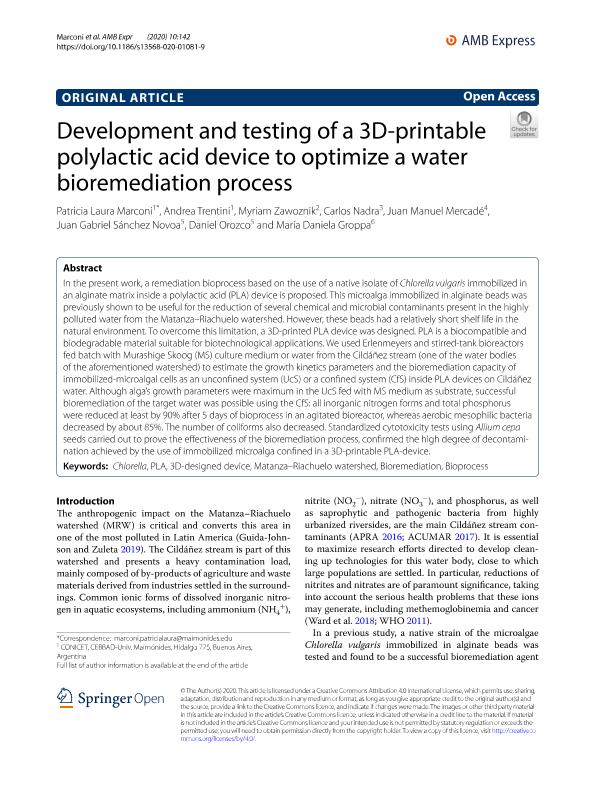Mostrar el registro sencillo del ítem
dc.contributor.author
Marconi, Patricia Laura

dc.contributor.author
Trentini, Andrea Giannina

dc.contributor.author
Zawoznik, Myriam Sara

dc.contributor.author
Nadra Chaud, Carlos Alberto

dc.contributor.author
Mercadé, Juan José
dc.contributor.author
Sanchez Novoa, Juan Gabriel
dc.contributor.author
Orozco, Daniel
dc.contributor.author
Groppa, María Daniela

dc.date.available
2022-09-23T15:46:41Z
dc.date.issued
2020-12
dc.identifier.citation
Marconi, Patricia Laura; Trentini, Andrea Giannina; Zawoznik, Myriam Sara; Nadra Chaud, Carlos Alberto; Mercadé, Juan José; et al.; Development and testing of a 3D-printable polylactic acid device to optimize a water bioremediation process; Springer; AMB Express; 10; 1; 12-2020; 1-9
dc.identifier.issn
2191-0855
dc.identifier.uri
http://hdl.handle.net/11336/170238
dc.description.abstract
In the present work, a remediation bioprocess based on the use of a native isolate of Chlorella vulgaris immobilized in an alginate matrix inside a polylactic acid (PLA) device is proposed. This microalga immobilized in alginate beads was previously shown to be useful for the reduction of several chemical and microbial contaminants present in the highly polluted water from the Matanza–Riachuelo watershed. However, these beads had a relatively short shelf life in the natural environment. To overcome this limitation, a 3D-printed PLA device was designed. PLA is a biocompatible and biodegradable material suitable for biotechnological applications. We used Erlenmeyers and stirred-tank bioreactors fed batch with Murashige Skoog (MS) culture medium or water from the Cildáñez stream (one of the water bodies of the aforementioned watershed) to estimate the growth kinetics parameters and the bioremediation capacity of immobilized-microalgal cells as an unconfined system (UcS) or a confined system (CfS) inside PLA devices on Cildáñez water. Although alga’s growth parameters were maximum in the UcS fed with MS medium as substrate, successful bioremediation of the target water was possible using the CfS: all inorganic nitrogen forms and total phosphorus were reduced at least by 90% after 5 days of bioprocess in an agitated bioreactor, whereas aerobic mesophilic bacteria decreased by about 85%. The number of coliforms also decreased. Standardized cytotoxicity tests using Allium cepa seeds carried out to prove the effectiveness of the bioremediation process, confirmed the high degree of decontamination achieved by the use of immobilized microalga confined in a 3D-printable PLA-device.
dc.format
application/pdf
dc.language.iso
eng
dc.publisher
Springer
dc.rights
info:eu-repo/semantics/openAccess
dc.rights.uri
https://creativecommons.org/licenses/by/2.5/ar/
dc.subject
3D-DESIGNED DEVICE
dc.subject
BIOPROCESS
dc.subject
BIOREMEDIATION
dc.subject
CHLORELLA
dc.subject
MATANZA–RIACHUELO WATERSHED
dc.subject
PLA
dc.subject.classification
Otros Tópicos Biológicos

dc.subject.classification
Ciencias Biológicas

dc.subject.classification
CIENCIAS NATURALES Y EXACTAS

dc.title
Development and testing of a 3D-printable polylactic acid device to optimize a water bioremediation process
dc.type
info:eu-repo/semantics/article
dc.type
info:ar-repo/semantics/artículo
dc.type
info:eu-repo/semantics/publishedVersion
dc.date.updated
2022-09-22T15:11:41Z
dc.journal.volume
10
dc.journal.number
1
dc.journal.pagination
1-9
dc.journal.pais
Alemania

dc.journal.ciudad
Berlín
dc.description.fil
Fil: Marconi, Patricia Laura. Consejo Nacional de Investigaciones Científicas y Técnicas; Argentina. Universidad Maimónides. Área de Investigaciones Biomédicas y Biotecnológicas. Centro de Estudios Biomédicos, Biotecnológicos, Ambientales y de Diagnóstico; Argentina
dc.description.fil
Fil: Trentini, Andrea Giannina. Consejo Nacional de Investigaciones Científicas y Técnicas; Argentina. Universidad Maimónides. Área de Investigaciones Biomédicas y Biotecnológicas. Centro de Estudios Biomédicos, Biotecnológicos, Ambientales y de Diagnóstico; Argentina
dc.description.fil
Fil: Zawoznik, Myriam Sara. Consejo Nacional de Investigaciones Científicas y Técnicas. Oficina de Coordinación Administrativa Houssay. Instituto de Química y Físico-Química Biológicas "Prof. Alejandro C. Paladini". Universidad de Buenos Aires. Facultad de Farmacia y Bioquímica. Instituto de Química y Físico-Química Biológicas; Argentina
dc.description.fil
Fil: Nadra Chaud, Carlos Alberto. Universidad Nacional de Tres de Febrero; Argentina. Autoridad de Cuenca Matanza Riachuelo.; Argentina
dc.description.fil
Fil: Mercadé, Juan José. Agencia de Protección Ambiental; Argentina
dc.description.fil
Fil: Sanchez Novoa, Juan Gabriel. Universidad Maimónides. Área de Investigaciones Biomédicas y Biotecnológicas. Centro de Estudios Biomédicos, Biotecnológicos, Ambientales y de Diagnóstico; Argentina
dc.description.fil
Fil: Orozco, Daniel. Universidad Maimónides. Área de Investigaciones Biomédicas y Biotecnológicas. Centro de Estudios Biomédicos, Biotecnológicos, Ambientales y de Diagnóstico; Argentina
dc.description.fil
Fil: Groppa, María Daniela. Consejo Nacional de Investigaciones Científicas y Técnicas. Oficina de Coordinación Administrativa Houssay. Instituto de Química y Físico-Química Biológicas "Prof. Alejandro C. Paladini". Universidad de Buenos Aires. Facultad de Farmacia y Bioquímica. Instituto de Química y Físico-Química Biológicas; Argentina
dc.journal.title
AMB Express
dc.relation.alternativeid
info:eu-repo/semantics/altIdentifier/url/https://link.springer.com/article/10.1186/s13568-020-01081-9
dc.relation.alternativeid
info:eu-repo/semantics/altIdentifier/doi/https://doi.org/10.1186/s13568-020-01081-9
Archivos asociados
